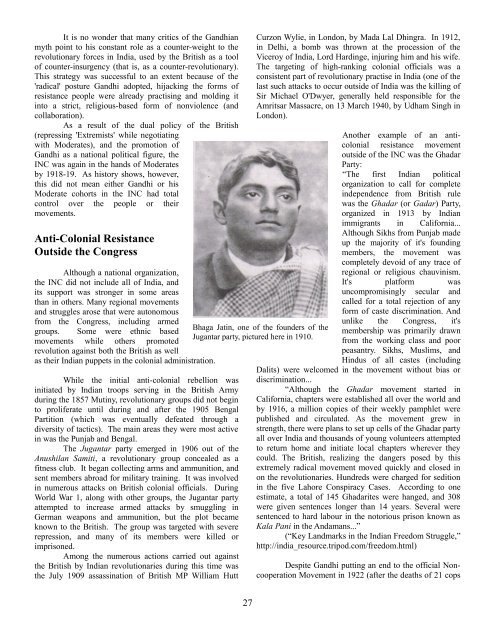smash-pacifism-zine
smash-pacifism-zine
smash-pacifism-zine
Create successful ePaper yourself
Turn your PDF publications into a flip-book with our unique Google optimized e-Paper software.
It is no wonder that many critics of the Gandhian<br />
myth point to his constant role as a counter-weight to the<br />
revolutionary forces in India, used by the British as a tool<br />
of counter-insurgency (that is, as a counter-revolutionary).<br />
This strategy was successful to an extent because of the<br />
'radical' posture Gandhi adopted, hijacking the forms of<br />
resistance people were already practising and molding it<br />
into a strict, religious-based form of nonviolence (and<br />
collaboration).<br />
As a result of the dual policy of the British<br />
(repressing 'Extremists' while negotiating<br />
with Moderates), and the promotion of<br />
Gandhi as a national political figure, the<br />
INC was again in the hands of Moderates<br />
by 1918-19. As history shows, however,<br />
this did not mean either Gandhi or his<br />
Moderate cohorts in the INC had total<br />
control over the people or their<br />
movements.<br />
Anti-Colonial Resistance<br />
Outside the Congress<br />
Although a national organization,<br />
the INC did not include all of India, and<br />
its support was stronger in some areas<br />
than in others. Many regional movements<br />
and struggles arose that were autonomous<br />
from the Congress, including armed<br />
groups. Some were ethnic based<br />
movements while others promoted<br />
revolution against both the British as well<br />
as their Indian puppets in the colonial administration.<br />
While the initial anti-colonial rebellion was<br />
initiated by Indian troops serving in the British Army<br />
during the 1857 Mutiny, revolutionary groups did not begin<br />
to proliferate until during and after the 1905 Bengal<br />
Partition (which was eventually defeated through a<br />
diversity of tactics). The main areas they were most active<br />
in was the Punjab and Bengal.<br />
The Jugantar party emerged in 1906 out of the<br />
Anushilan Samiti, a revolutionary group concealed as a<br />
fitness club. It began collecting arms and ammunition, and<br />
sent members abroad for military training. It was involved<br />
in numerous attacks on British colonial officials. During<br />
World War 1, along with other groups, the Jugantar party<br />
attempted to increase armed attacks by smuggling in<br />
German weapons and ammunition, but the plot became<br />
known to the British. The group was targeted with severe<br />
repression, and many of its members were killed or<br />
imprisoned.<br />
Among the numerous actions carried out against<br />
the British by Indian revolutionaries during this time was<br />
the July 1909 assassination of British MP William Hutt<br />
Curzon Wylie, in London, by Mada Lal Dhingra. In 1912,<br />
in Delhi, a bomb was thrown at the procession of the<br />
Viceroy of India, Lord Hardinge, injuring him and his wife.<br />
The targeting of high-ranking colonial officials was a<br />
consistent part of revolutionary practise in India (one of the<br />
last such attacks to occur outside of India was the killing of<br />
Sir Michael O'Dwyer, generally held responsible for the<br />
Amritsar Massacre, on 13 March 1940, by Udham Singh in<br />
London).<br />
Another example of an anticolonial<br />
resistance movement<br />
outside of the INC was the Ghadar<br />
Party:<br />
“The first Indian political<br />
organization to call for complete<br />
independence from British rule<br />
was the Ghadar (or Gadar) Party,<br />
organized in 1913 by Indian<br />
immigrants in California...<br />
Although Sikhs from Punjab made<br />
up the majority of it's founding<br />
members, the movement was<br />
completely devoid of any trace of<br />
regional or religious chauvinism.<br />
It's platform was<br />
uncompromisingly secular and<br />
called for a total rejection of any<br />
form of caste discrimination. And<br />
unlike the Congress, it's<br />
membership was primarily drawn<br />
from the working class and poor<br />
peasantry. Sikhs, Muslims, and<br />
Hindus of all castes (including<br />
Dalits) were welcomed in the movement without bias or<br />
discrimination...<br />
“Although the Ghadar movement started in<br />
California, chapters were established all over the world and<br />
by 1916, a million copies of their weekly pamphlet were<br />
published and circulated. As the movement grew in<br />
strength, there were plans to set up cells of the Ghadar party<br />
all over India and thousands of young volunteers attempted<br />
to return home and initiate local chapters wherever they<br />
could. The British, realizing the dangers posed by this<br />
extremely radical movement moved quickly and closed in<br />
on the revolutionaries. Hundreds were charged for sedition<br />
in the five Lahore Conspiracy Cases. According to one<br />
estimate, a total of 145 Ghadarites were hanged, and 308<br />
were given sentences longer than 14 years. Several were<br />
sentenced to hard labour in the notorious prison known as<br />
Kala Pani in the Andamans...”<br />
(“Key Landmarks in the Indian Freedom Struggle,”<br />
http://india_resource.tripod.com/freedom.html)<br />
Bhaga Jatin, one of the founders of the<br />
Jugantar party, pictured here in 1910.<br />
Despite Gandhi putting an end to the official Noncooperation<br />
Movement in 1922 (after the deaths of 21 cops<br />
27



